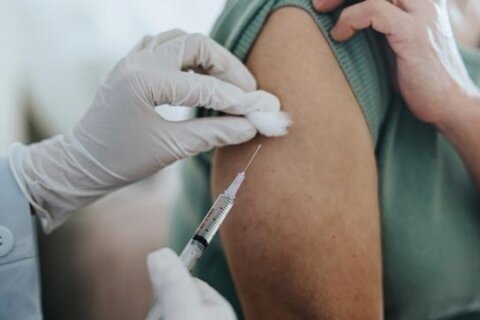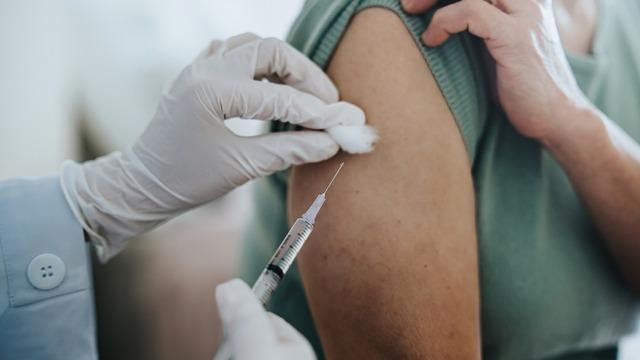
▶ Watch Video: CDC recommends updated COVID boosters aimed at new variants
Ahead of the rollout of this fall’s new COVID-19 vaccines, a Centers for Disease Control and Prevention work group wrestled for months over whether shots should be recommended for all eligible Americans or only for some of the most vulnerable groups.
The latter approach, for example, has been taken up by other countries like the United Kingdom, which is again offering their fall shots only to people at highest risk of severe disease, like seniors and those with underlying medical conditions.
But a panel of the CDC’s outside experts ultimately voted Tuesday in favor of broad recommendations for the shots, thanks in part to CDC data finding that healthy, young and mostly unboosted Americans are still being hospitalized by the virus.
“There was some concern that the work group entered its deliberations this summer assuming that a universal vaccination strategy was the obvious policy choice, but I just want to reiterate that that was very much not the case,” Dr. Matthew Daley, head of the COVID-19 vaccines work group within the CDC’s Advisory Committee on Immunization Practices, said at their meeting Tuesday. But that’s where the data took them.
The updated shots, which were greenlighted Monday by the Food and Drug Administration, have been reformulated to target the newer XBB variants of the virus.
This reformulation is why health officials are calling this year’s shots the “2023-2024 COVID-19 vaccine” or simply the “updated COVID-19 vaccine” — no longer using the word “boosters,” like additional doses have been called in previous rollouts.
All Americans, including children as young as 6 months old who are eligible for the revised shots, are now being urged to get a dose ahead of the fall and winter virus season.
“CDC is now recommending updated COVID-19 vaccination for everyone 6 months and older to better protect you and your loved ones,” CDC Director Dr. Mandy Cohen said Tuesday in a release following the panel’s vote.
Daley said the group “essentially started with a blank slate” as they sought to reevaluate vaccine recommendations ahead of this fall.
Among the data they asked the CDC to gather was on whether healthy children and young adults were still at risk of severe disease from the virus.
While rates of COVID-19 hospitalizations remain worst in seniors and in babies under 6 months old, the agency presented data finding that otherwise healthy Americans from all age groups are still being hospitalized from COVID-19.
Among school-age children ages 5 to 11 years old, 23% of hospitalizations were in kids with no underlying conditions. The majority of children facing severe COVID-19 had not received a booster shot and many were unvaccinated.
“That was the most persuasive line of argument for me, knowing that there were deaths, including in children, including in those without chronic conditions. And my perception is that those deaths are vaccine preventable,” Daley said.
Only one member of the 14-member panel voted against the universal recommendation.
“I just want to be clear that I am not against this vaccine. The data do look great,” ACIP member Dr. Pablo Sanchez said, following his dissenting vote. Sanchez voiced concern over what he saw as “extremely limited data” on the benefits for children and healthier young adults from the vaccine.
The balance of benefits and risks could be too narrow for some young adult males who are at higher risk of myocarditis, a rare side effect from the shots, Sanchez suggested. That put him at odds with others on the panel who cited data suggesting benefits of the shots outweigh risks even for those with the highest myocarditis risk.
Myocarditis, an inflammation of the heart muscle, usually responds well to treatment, the CDC says, and research shows people are more likely to develop myocarditis from a COVID infection than from the vaccine.
“I think all of that needs to be weighed. And so that’s why I hesitate to make it just a universal recommendation, even though I do support vaccination with the COVID vaccine,” Sanchez said.
Trying to come up with tailored recommendations could also be impractical to implement, CDC officials said the work group concluded, and risked setting up barriers to vaccination for those who are at greatest risk.
More than 7 in 10 adults are already at higher risk of severe COVID-19 due to being overweight, the agency said, and would qualify as a higher-risk group regardless.
“Modeling projects more hospitalizations and deaths are averted when updated doses are universally recommended compared to no recommendation or recommendation only for persons 65 years and older,” the CDC’s Megan Wallace told the panel.
Officials also stressed that, unlike other vaccines, insurance coverage of the shots would not be directly tied to the panel’s recommendations.
Insurers were required to cover the shots immediately after they were greenlighted by the FDA under a law passed earlier in the pandemic.
And while most Americans are now recommended to get a shot, officials said they still planned to focus their promotion of the shots to those who were at the highest risk of severe disease and might benefit most.
“Under a universal recommendation, we will still have targeted communications for older adults, immunocompromised persons, and others at higher risk,” the CDC’s Dr. Barbara Mahon said.








